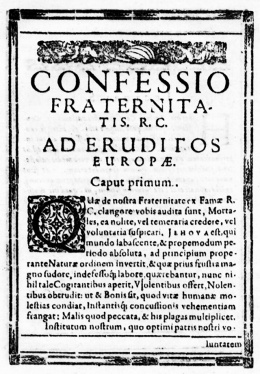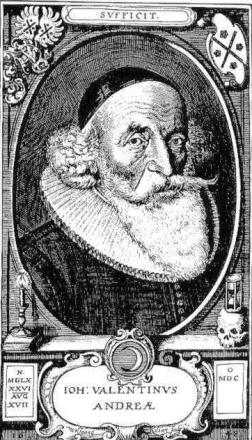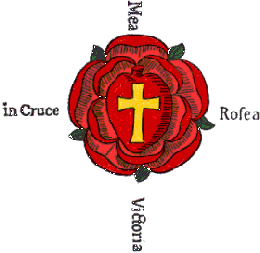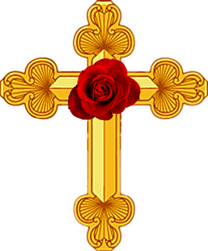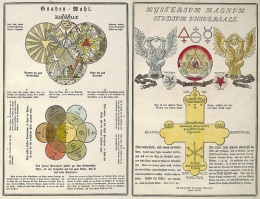Rosicrucianism
THIS SITE UNDER CONSTRUCTION
Rosicrucianism refers to a movement which arose in Europe in the early 17th century. The word “Rosicrucian” is derived from the name “Christian Rosenkreutz” or “Rose Cross”. The existence of the order first came into public notice, when two Latin pamphlets, known as the Fama Fraternitatis and as Confessio Fraternitati, were published in Germany describing the foundation and aims of this esoteric order. These manifestos aroused a lot of excitement and a third publication, The Chemical Wedding of Christian Rosenkreutz, increased the mystery. [1]
The object of the mysterious Order of Rosicrucians was to throw occult light upon the misunderstood Christian religion and to explain the mystery of Life and Being from the scientific standpoint in harmony with religion, and a high spiritual teacher with the name of Christian Rosenkreuz appeared in Europe to commence that work. His very name is an embodiment of the manner and the means by which the present day man is transformed into the Divine Superman. And the symbol, the Christian Rose Cross, shows the end and aim of human evolution, the road to be traveled, and the means whereby that end is gained. [2]
Four Distinct Theories
1) There is an assumption that the Rosicrucian Order existed historically in accordance with the description in Fama Fraternitatis which appeared in print in 1614. This pamphlet reminds the reader of God’s goodness, warns the intelligentsia of following false prophets and ignoring the true knowledge, and makes clear that a reformation is necessary.
2) Some Masonic brethren accept the historical existence of the “Brotherhood of the Rose Cross” and believe that it originated in mediaeval Europe as an outgrowth of alchemical speculation and that Johann Valentin Andrea, a German theologian, was the founder and might have reformed an existing society established by Sir Henry Cornelius Agrippa; some believe that Rosicrucians represented the first European invasion of Buddhist and Brahmin culture; and still others believe it was founded in Egypt during the philosophic supremacy of that empire.
3) The third theory takes the form of a sweeping denial of Rosicrucianism claiming that it was entirely a product of imagination.
4) The fourth theory asserts that the Rosicrucians actually possessed all the supernatural powers with which they were credited. According to this theory, the true Rosicrucian Brotherhood consisted of a limited number of highly developed adepts who possessed the secret of the Philosopher’s Stone and knew the process of transmuting the base metals into gold but taught that these were only allegorical terms concealing the true mystery of human regeneration through the transmutation of the “base elements” of man’s lower nature into the “gold” of intellectual and spiritual realization. [3]
Connections with Theosophy
H.P.Blavatsky
H. P. Blavatsky said that the actual origin of the Order may be ascertained by any earnest, sincere student of Occultism who goes to Asia Minor and contacts some of the Brotherhood, if he is able to decipher a Rosicrucian manuscript which is carefully preserved in the very Lodge founded by the first Kabbalist calling himself a Rosicrucian, but which now goes under another name. [4]
Rudolf Steiner
Rudolf Steiner, an Austrian occult philosopher, who was for a time a Theosophist and established a new German branch before he founded his own organization, which he called Anthroposophy, gave a series of lectures about the Theosophy of the Rosicrucian in May and June of 1907. [5] In his first lecture he talked about Christian Rosenkreuz, an exalted Individuality, who appeared in the year 1459 as a teacher of Rosicrucianism with a small circle of initiated pupils. Until far into the eighteenth century, the wisdom of the Rosicrucian Order was preserved strictly within the secret Brotherhood, bound by inviolate rules which separated its members from the exoteric world, but in the eighteenth century it was the mission of this Brotherhood to allow certain esoteric truths to flow, by spiritual ways, into the culture of Middle Europe. He stated that when Rosicrucian wisdom was intended to flow gradually into the general life of culture, a kind of betrayal took place and that’s why the sources of Rosicrucian wisdom, and above all its great Founder, who since its inception had been constantly on the physical plane in different incarnations, had to withdraw. Thus, during the first half and also during a large part of the second half of the nineteenth century, little of the Rosicrucian wisdom could be discovered until the end of the 19th century when Rosicrucian wisdom became accessible and was allowed to flow into general culture.
He further explained, that in Rosicrucianism there is an essential difference between the actual discovery of spiritual truths and the understanding of them and that only those who have developed spiritual faculties in a fairly high degree can themselves discover a spiritual truth in the higher worlds. And the relationship between teacher and pupil in Rosicrucianism is fundamentally different from that prevailing in other methods of Initiation; it cannot in any way be said to be based upon belief in authority. He emphasizes the importance of understanding the seven-fold nature of man according to the Rosicrucian teaching and that the physical world cannot be understood without knowledge of how it is constituted. [6]
Franz Hartmann
Franz Hartmann, a German physician, theosophist, and author of esoteric and occultism works, wrote several books about Rosicrucianism. His book Among the Adepts: An Adventure among the Rosicrucians, is an instructive tale in which the narrator encounters a dwarf in the Tyrolian alps who leads him to the Brothers of the Golden and Rosy Cross, where he commences monastic study. The narrator learns that “the name ‘Rosicrucian Order,’ “is a comparatively modern invention, and was first used by Johann Valentin Andreae, who invented the story of the knight Christian Rosencreuz for the same purpose as Cervantes invented his ‘Don Quichote de la Mancha,’ namely, for the purpose of ridiculing the would-be Adepts, reformers, and gold-makers of his age, when he wrote his celebrated Fama Fraternitatis.’”
He further learns, that “before his pamphlet appeared, the name Rosicrucian did not mean a person belonging to a certain organized society of that name, but it was a generic name, applied to occultists, adepts, alchemists of a higher order, in possession of some occult knowledge and acquainted with the secret signification of the Rose and the Cross; symbols which have been adopted by the Christian Church, which were, however, not invented by her, but used by occultists thousands of years before Christianity was known. These symbols do not belong exclusively to the Christian Church. They are as free as the air for anyone who can grasp their meaning, but unfortunately very few of your Christians know that meaning; they only worship the external forms, and know nothing about the principles which those forms represent.”[7]
In another book about adepts and Rosicrucians Hartmann writes, that the religion of the Rosicrucians consists neither of outward observations, nor of the mere belief in theories, dogmas and articles of faith. It is about the result of one’s own inner experiences which for everybody happens through the opening of his inner Self and these experiences lead to the gradual growth of inner spiritual self-knowledge. [8]
In still another book, in which he discusses the secret symbols of symbolism, Hartmann, similarly to Steiner, claims that “there were true and false Rosicrucians during the Middle Ages, as there are true and merely nominal Christians today. The Pseudo-Rosicrucians were very numerous; the true ones were seldom to be found.” [9]
Alexander Wilder
Alexander Wilder, a close associate of H. P. Blavatsky during the writing of Isis Unveiled, who was then Vice-President of the Theosophical Society, wrote an article about the Rosicrucians in The Theosophist in 1880. He wrote, that Christian Rosenkreuz had been “a traveler in the East, where he had received instruction into the profoundest lore — magian, rabbinic, theurgic and alchemic. Among other acquirements, were the knowledge of the philosopher's stone, the art of transmuting metals, and the elixir of life. Returning to Germany, he established a little fraternity of eight disciples, obligating them to keep the doctrine secret for the space of one hundred and twenty years after his death.” He further wrote that the Rosicrucians were engaged in no movement or conspiracy against the ruling powers and that their aim was the diminishing of human wretchedness, the spread of education, the advancement of learning, science, universal enlightenment, and love. He explained, that they possessed profound and occult knowledge, such as the alchemists, Arabian thaumaturgists, Egyptian and Chaldean wise men had brought forth, and that their one high purpose was to benefit their fellow-creatures, body and soul.
He explains: “The Rosicrucian Brotherhood possessed a heritage of all the arcane systems and religions of the earlier world. Hargrave Jennings, their latest chronicler imputes to them the symbols, traditions and learning of the principal mystic fraternities. The Hermetic philosophy of Egypt, the fire-theosophy of Persia, Druid-worship, Gnosticism, the Kabala, the Ancient Mysteries and Orders of Knighthood, Magic, Alchemy, Hindu beliefs, etc., all are treated by him in this connection."[10]
Others
Quite a few people have been influenced by both Rosicrucianism and Theosophy, including artist Jean Delville, occultist William Wynn Westcott, novelist Edward Bulwer-Lytton, scholar Alexander Wilder, and medium Paschal Beverly Randolph.
Rosicrucian Symbols
In an anonymous manuscript of the eighteenth century bearing the earmarks of Rosicrucian Cabbalism appeared this picture on the left.
The rose blossoms by unfolding and is symbolic of spiritual unfoldment. The red color refers to the blood of Christ, and the golden heart concealed in the flower represents the spiritual gold concealed within the human nature. It symbolizes the heart, the virtues of love and compassion. The number of its petals being ten is also a subtle reminder of the perfect Pythagorean number.
[11][12][13]
Viewed in fullness, the symbol on the right contains the key to man's past evolution, his present constitution and future development, together with the method of attainment. When the cross is represented with a single rose in the center it symbolizes the spirit radiating from itself the four vehicles: the dense, vital, and desire bodies plus the mind; where the spirit has drawn into its instruments and become the indwelling human spirit.
There was a time when the threefold spirit hovered above its vehicles and was unable to enter and then the cross stood alone without the rose (early third of Atlantis). There was even a time when the upper limb of the cross was lacking (the Lemurian Epoch) when man had only the dense, vital and desire bodies, but lacked the mind. Then the animal nature was paramount and man followed desire without reserve. At a still earlier time (Hypoerborean Epoch) man was without the desire body and possessed only the dense and vital bodies. The man-in-the-making was like the plants: chaste and devoid of desire. The symbol for that was a straight shaft, a pillar.
The plant is innocent, but not virtuous; it has neither desire nor choice. Man has both. [14]
It is said of this cross that is is made of spiritual gold; it bears the alchemical symbols of salt, sulphur, and mercury; also a star of the plants; and around it are the four words FIATH, HOPE, LOVE, and PATIENCE. The double-headed eagle, or Phoenix, subtly foreshadows the ultimate androgynous state of the human creature. Rosicrucian alchemy was not concerned with metals alone. Man's own body was the alchemical laboratory, and non could reach Rosicrucian adept-ship until he had performed the supreme experiment of transmutation by changing the base of metals of ignorance into the pure gold of wisdom and understanding.[15][16]
Online resources
Books
- Texts and Publications at AMORC website.
Articles
- The Brethren of the Rosy Cross by Alexander Wilder
- The Rosicrucians at WisdomWorld.org
- Secret Doctrines of the Rosicrucians by Magnus Incognito
- Theosophy of the Rosicrucian by Rudolf Steiner
- Secret Symbols by the Rosicrucians by Franz Hartmann
Notes
- ↑ Yates, Frances A. The Rosicrucian Enlightenment. Frogmore, St. Albans: Granada Publishing Limited, 1975. Print. Page 58
- ↑ Heindel, Max. THE ROSICRUCIAN COSMO-CONCEPTION. Oceanside, Ca.: Rosicrucian Fellowship, 1998. Print., page 518
- ↑ Hall, Manly P. The Secret Teachings of All Ages. Altenmünster: Jazzybee Verlag Jürgen Beck. Kindle edition, chapter „The Fraternity of the Rose Cross
- ↑ Great Theosophists - The Rosicrucians. THEOSOPHY 26.7 (1938): 290–296. http://www.wisdomworld.org/setting/rosicrucians.html#. Web. 17 Feb. 2017.
- ↑ Steiner, Rudolf. “Theosophy of the Rosicrucian.” Rudolf Steiner Archive & eLib Bn/Ga.99 (1907): n. pag. http://wn.rsarchive.org/Lectures/GA099/English/RSP1966/TheRos_index.html. Web. 17 Feb. 2017.
- ↑ Steiner, Rudolf. “The New Form of Wisdom.” Rudolf Steiner Archive & eLib Bn/Ga.99 (1907): n. pag. http://wn.rsarchive.org/Lectures/GA099/English/RSP1966/19070522p01.html. Web. 19 Feb. 2017.
- ↑ Hartmann, Franz. With the Adepts, an Adventure among the Rosicrucians. http://www.philaletheians.co.uk/study-notes/mystic-verse-and-insights/with-the-adepts-by-franz-hartmann.pdf Web. 8 May 2017
- ↑ Hartmann, Franz. Unter den Adepten und Rosenkreuzern. Berlin: Schikowski Verlag, 1963. Print, page 85
- ↑ Hartmann, Franz. Cosmology or the Mysteries if the Universe. The Religion of Christ by Means of the Secret Symbols of the Rosicrucians. https://selfdefinition.org/magic/Franz-Hartmann-Secret-Symbols-of-the-Rosicrucians.pdf, Web. 8 May 2017
- ↑ Wilder, Alexander. The Brethren of the Rosy cross. The Theosophical University Press Online. http://www.theosociety.org/pasadena/forum/f27n08p480_the-brethren-of-the-rosy-cross.htm#, 1949. Web. 17 Feb. 2017.
- ↑ Geheime Figuren der Rosenkreuzer aus dem 16. Und 17. Jahrhundert. http://images.library.wisc.edu/HistSciTech/EFacs/GeheimeFiguren/reference/histscitech.geheimefiguren.i0004.pdf, n.d. Web. 8 May 2017
- ↑ Hall, Manly P. The Secret Teachings of All Ages. Altenmünster: Jazzybee Verlag Jürgen Beck. Kindle edition, chapter „The Fraternity of the Rose Cross
- ↑ Hartmann, Franz. The Secret Symbols of the Rosicrucians. https://selfdefinition.org/magic/Franz-Hartmann-Secret-Symbols-of-the-Rosicrucians.pdf, Web. 8 May 2017
- ↑ Heindel, Max. THE ROSICRUCIAN COSMO-CONCEPTION. Oceanside, Ca.: Rosicrucian Fellowship, 1998. Print., page 534 ff.
- ↑ Hall, Manly P. The Secret Teachings of All Ages. Altenmünster: Jazzybee Verlag Jürgen Beck. Kindle edition, chapter „The Fraternity of the Rose Cross
- ↑ Geheime Figuren der Rosenkreuzer aus dem 16. Und 17. Jahrhundert. http://images.library.wisc.edu/HistSciTech/EFacs/GeheimeFiguren/reference/histscitech.geheimefiguren.i0004.pdf, n.d. Web. 8 May 2017
